Trending
Real estate’s love-hate relationship with de Blasio
Two years into his term, the mayor has proven to be far more pro-development than many expected. So why hasn’t he won over more developers?

On an unseasonably mild morning in October, the roughly 50 people who showed up for a press conference at Stuyvesant Town witnessed a strange spectacle: Bill de Blasio, New York’s progressive mayor and self-declared fighter for the working class, chumming it up with Jonathan Gray, the head of global real estate at The Blackstone Group, the world’s largest private equity firm.
The two men were there to announce Blackstone’s $5.3 billion deal to buy Manhattan’s biggest apartment complex, which included a commitment by the company to preserve 5,000 units of affordable housing. “I know that [Gray] understood from the beginning that there was an opportunity to do something good and lasting here, and he put his heart into it,” de Blasio said.
Gray, in turn, had his own flattering assessment of City Hall.
“It felt like working with a very skilled deal team, almost like another investment firm,” Gray recently told The Real Deal. “The most impressive thing was the 24/7 nature of the transaction over more than a week and just how committed they were to doing this.”
While the de Blasio administration has been saddled with a reputation for being inefficient and slow moving, that was clearly not an issue here.
To the mayor’s real estate supporters, the deal seemed to prove what they had been saying all along — that de Blasio is a pragmatic leader who will work with developers and real estate players to get things done.
And yet, midway into his first term, de Blasio is far from being embraced by New York’s real estate community. This despite taking stances that can be described as pro-development, among them, fighting to restore the 421a tax abatement, backing the controversial rezoning of Midtown East and supporting large-scale developments in exchange for affordable housing.
In a business where having a good relationship with the political-powers-that-be can pay serious financial dividends, few developers will criticize de Blasio on the record. For this story, TRD spoke with nearly two dozen people in the real estate orbit, both on and off the record, who have had or observed dealings with de Blasio or his administration.
Although the situation is nowhere near as bad as what many had predicted when de Blasio was elected, it is safe to say that the industry’s relationship with the mayor is mixed at best. While he has a handful of vocal allies (see sidebar), there are many more individuals behind the scenes who are either less than impressed or critical of his performance to date.
In fact, many real estate players are, at best, only grudgingly accepting of the mayor. The criticisms of him range from being a micro-manager to allowing crime to rise (even though the statistics show the opposite) to being too focused on affordable housing to the detriment of other initiatives such as commercial construction.
This is a concerning state of affairs for both sides. The real estate industry and City Hall have always relied on each other. Not only do they need each other to keep development churning, but they’re also mutually dependent when it comes to improving the quality-of-life issues that are key to both political popularity and real estate values. And given that de Blasio has made one of his major goals to create or preserve 200,000 affordable housing units by 2025, he arguably needs the industry even more than previous mayors.
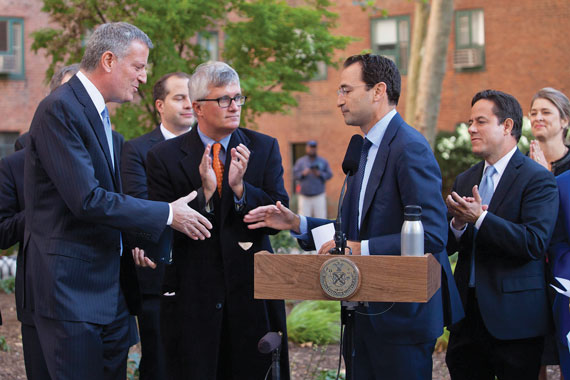
Mayor de Blasio (left) and Jonathan Gray (right) of Blackstone announced the $5.3 billion Stuy Town deal at a press conference in October.
De Blasio declined a request for an interview, but Deputy Mayor of Housing and Economic Development Alicia Glen said the administration’s relationship with the industry is solid and improving by the day.
“I think it’s changed in the sense that with each month or quarter that goes by, the industry is even more satisfied with the [administration’s] ability to get deals done,” she said.
As for the critics, she said, “I’m not having a lot of self-esteem issues with them.”
Bloomberg’s shadow
Call it a hard act to follow. During the 2012 groundbreaking ceremony for Hudson Yards, Related Companies’ chairman Stephen Ross introduced Michael Bloomberg as “the greatest mayor in the history of New York.”
Flash forward two years later, after Two Trees Management reached a deal to redevelop the former Domino Sugar factory, company CEO David Walentas was quoted in New York magazine as saying, “I think de Blasio’s a disaster for the city. His whole administration are amateurs and left wing.”
Walentas later backtracked. And while the two comments were made under very different circumstances, they nevertheless underscore an unavoidable shortcoming that the real estate industry, and the business community at large, sees in de Blasio: He’s not Bloomberg.
The two men could not be more different. Bloomberg, a billionaire who started his career on Wall Street and then built his fortune on the giant media company he founded, was in many ways cut from the same cloth as the development community. The former CEO ran City Hall like a company, with a strong focus on data, efficiency and delegation of duties.
It wasn’t just his business acumen: Bloomberg pursued development and planning initiatives on a scale that approached that of Robert Moses. He championed major development projects like Hudson Yards, the Cornell Tech Campus on Roosevelt Island and the Atlantic Yards Development (now Pacific Park).
During his 12-year tenure, nearly 40 percent of the city, including underutilized waterfront areas and the Far West Side, was rezoned. The expansion of parks and pedestrian plazas as well as bike access were credited with improving the quality of life in the city. All of this drew hearty applause from the real estate community, which benefited from soaring real estate values fueled in large part by rich foreigners investing in luxury apartments. Between 2005 and 2014, the average Manhattan apartment sales price jumped by a massive 40.7 percent, according to appraisal firm Miller Samuel.
Amid such a boom, any successor was bound to pale in comparison. But it was especially the case for de Blasio, a political activist-turned-consultant-turned-politician, who rode to City Hall on a wave of working- and middle-class disenchantment. “He was known as a left-leaning Democrat, and generally that crowd is not associated with being pro-development,” recalled one real estate executive.
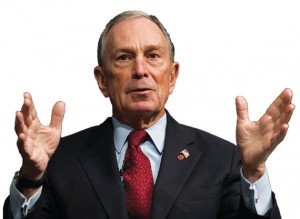
Michael Bloomberg
Facing City Council speaker Christine Quinn, who was well respected in the real estate industry and considered Bloomberg’s heir-apparent, de Blasio took his “tale of two cities” platform and positioned himself as a populist willing to take on income inequality. In a 2013 interview with TRD, the then-candidate went so far as to say the “relationship between the city and its developer community needs a reset.”
The statement sent ripples through the real estate industry.
“Everybody thought de Blasio was going to be a disaster,” said Don Peebles, a developer who backed de Blasio during the election. “I had people tell me they would move to Canada if he won.”
Peebles, a high-profile Democrat, has since soured on de Blasio and is now planning to mount a run for mayor in 2017.
‘Build it’ Bill
Despite what Peebles claims he heard back in 2013, nobody in the New York City real estate industry appears to be fleeing.
Since taking the reins, de Blasio has proven to be far from the radical leftist that many feared. Rather, he has arguably been a solid real estate advocate.
On 421a, the mayor sided with the industry — and against Governor Andrew Cuomo — by arguing that affordable-housing developers should be allowed to use non-union contractors during certain phases of construction. De Blasio’s proposal for 421a would grant tax abatements over a longer period — up to 35 years — and would only apply to rentals, not condos. That much-desired increased abatement period comes in exchange for developers upping the amount of affordable units they’re setting aside from 20 percent to 25 percent or 30 percent.
The state legislature passed a version of the program in June that adopted key aspects of de Blasio’s proposals, but reform was contingent on unions and developers reaching a compromise on construction wages — which they failed to do by a January deadline. In a blow to both sides, the program expired last month, but many believe it can still be resurrected.
The mayor’s economic development team has also presided over several big public-private real estate projects and deals — the redevelopment of Domino Sugar, the Hallets Point project and the sale of Stuyvesant Town — that have delivered generous public subsidies to developers.
For example, at Stuy Town, the city is shelling out $225 million in subsidies, including a $144 million de-facto cash gift (in the form of a self-amortizing loan) and a waiver of the mortgage recording tax valued at $77 million. And although the city won a commitment from Blackstone and its partner Ivanhoe Cambridge to keep 5,000 units affordable for 20 years, some affordable housing advocates noted that many of the apartments are merely affordable for families with six-figure incomes.

Rendering of Hallets Point
Michael McKee, treasurer of the tenant advocacy group Tenants Political Action Committee, called the deal a “mixed bag,” lamenting that most of the units deemed affordable are out of reach for middle-income families and that the deregulation of Stuy Town’s affordable units over past years was not reversed.
“Blackstone would not be buying this if they didn’t think they would be making money; they are not a charity,” he added.
At the Domino Sugar factory, the administration waged what appeared to be a tough standoff with Two Trees. But in the end, the city won only 40 additional affordable units.
“If that’s a win [for the mayor], I’d hate to see what a loss looks like,” Jason Haber, a residential broker at Warburg Realty, told TRD at the time.
Ron Moelis — CEO of L+M Development Partners — told TRD that after coming to a tentative agreement with the Bloomberg administration on the Greenpoint Landing project that his firm is co-developing, it was “frustrating” to have to renegotiate the deal terms. But while the new deal ultimately left L+M and its partner Park Tower Group with fewer subsidies, Moelis acknowledged that the city has a responsibility to get the best possible deal for its taxpayers and that it was logical to revisit deals struck years ago in a different market environment.
“They took a hard line but also weren’t unreasonable in terms of what we could produce,” he said.
But perhaps the best gauge of the new administration’s policies on the industry is the fact that the real estate market has continued to boom under de Blasio.
Although de Blasio initially sparked concerns in the real estate industry over his push to adopt mandatory inclusionary zoning, which would require developers in newly rezoned neighborhoods to set aside a portion of units as affordable, the mayor’s final rezoning proposal has turned out to be not as scary as many had feared.
The plan, which is set to go before the City Council this month, would eliminate several zoning restrictions for developers on height, design and parking in rezoned areas.
New York City Comptroller Scott Stringer recently said that East New York’s so-called “affordable” apartments would be too expensive for more than half of current residents. Meanwhile, the advocacy group Association for Neighborhood Housing and Development has also criticized the mandatory inclusionary zoning plan for not being stringent enough in its affordability requirements. Under the plan, apartments priced for households making more than $100,000 per year can be counted as affordable.
All of the city’s borough boards have opposed the mayor’s plan, in part for being too soft on developers as well as too narrowly focused. “Our goal as a city should not be just to achieve a goal of 200,000 units but to meet the individual needs of each and every community in this city,” Bronx Borough President Ruben Diaz Jr. said in December.
Not surprisingly, some developers have leapt to the mayor’s defense.
MaryAnne Gilmartin, the CEO of Forest City Ratner, who has worked with de Blasio on the Atlantic Yards development, argued that the mayor’s housing and rezoning agenda are in line with both the interests of the real estate industry and the city.
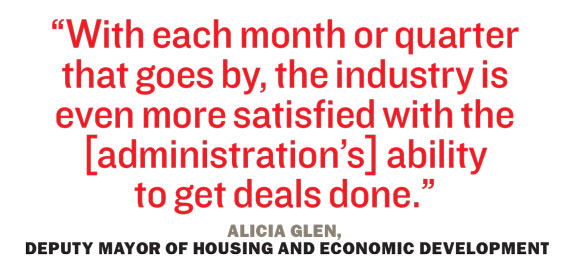 “What are you really going to criticize him for? Wanting more affordable housing?” she said. “I would say the mayor is doing what needs to be done to create a livable 24-hour, 21st-century city, and some people don’t like that.”
“What are you really going to criticize him for? Wanting more affordable housing?” she said. “I would say the mayor is doing what needs to be done to create a livable 24-hour, 21st-century city, and some people don’t like that.”
The Real Estate Board of New York and the Partnership for New York City, a business advocacy group, have both come out in favor of the mayor’s rezoning proposal.
“Zoning actions to increase density and reduce costs are among the only significant tools the city has to induce the development of housing that responds to the needs of our growing population of low-, moderate- and middle-income New Yorkers,” said the Partnership’s president Kathryn Wylde at a public hearing in December.
The micro-manager
While de Blasio’s policies may be better than expected for developers, that doesn’t mean every sector of the real estate industry has benefited.
Landlords of rent-regulated buildings, for example, took a hit when de Blasio backed a decision in June by the Rent Guidelines Board to freeze rents for one year.
“We owners of rent-regulated apartment buildings really don’t have a warm and fuzzy relationship with the city,” said Joseph Strasburg, who heads the landlord advocacy group Rent Stabilization Association. De Blasio, he added, is “basically ignoring the reality of those owners who really provide affordable housing.”
Rent freezes, he argued, can result in landlords no longer being able to afford to invest in repairs or renovations, to the detriment of stabilized tenants.
Gerald Guterman, a real estate investor who has been highly critical of the city’s concessions in the Stuy Town deal, had these blunt words about the administration: “The problem is not de Blasio’s policies, it’s the quality of people that don’t know the real estate business.”
Across the board, the most often heard critique of de Blasio within the real estate industry is that the administration has generally been difficult to work with.
One local politician, who spoke on the condition of anonymity, said, “We hear that complaint all the time from all corners.”
While most industry leaders speak highly of the mayor’s top deputies — including Glen, a former Goldman Sachs executive, and Chair of the NYC Planning Commission Carl Weisbrod, a City Hall veteran well-versed in economic development issues — the mid-level staffers are perceived as far more difficult to work with than they were under Bloomberg.
On top of this, the mayor is seen as having a tendency to micro-manage. “Previously, deputies were more empowered to make decisions. Now big decisions are held up at the top level. This slows up everything,” said one real estate executive.
De Blasio’s ability to manage Albany has also been questioned. The mayor’s simmering feud with Cuomo — the two have butted heads over everything from whether to mandate union contractors at affordable housing to how to deal with the city’s homeless population — has delayed some projects, one real estate insider argued.
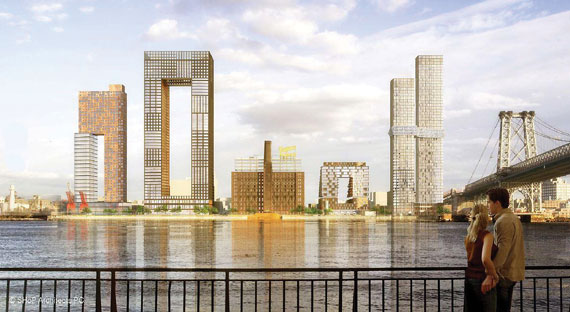
A rendering of Two Trees’ Domino Sugar Factory development in Williamsburg
There is also the criticism that, when it comes to development, the administration’s agenda is too myopic, with an affordable housing agenda that focuses only on a certain set of neighborhoods.
“I just feel like they have such a very specific set of priorities, it’s hard to get anything other than those things done,” a source said.
“For example, East New York is their focus now. If you have a project that’s amazing in Sunset Park and will bring everything they’re looking for, it’s two years away at a minimum.”
Another real estate executive went even further, saying, “There is no clear job-creation strategy and hasn’t been for the entirety of the term. The only solution to income inequality or any other social justice issue is creating or preserving 200,000 units of affordable housing and universal pre-K. That’s it.”
Glen defended the administration, calling the charges of inefficiency “patently ridiculous.”
“In fact I would argue quite the contrary, that decisions are made faster here than they have been in years,” she said.
She described City Hall as having a “laser-sharp focus” in supporting the commercial sector and pointed to the administration’s push to develop industrial areas, including the Brooklyn Navy Yard, and individual projects like the rezoning of Midtown East and the deal to bring Google to Pier 57 in Chelsea.
Forging ties with REBNY
Last month, at REBNY’s annual gala — the industry’s see-and-be-seen event of the year — de Blasio and his top lieutenants rubbed shoulders with the industry’s biggest players. In fact, the mayor seemed to work the crowd for longer than expected. TRD spotted him making the rounds with Gilmartin, Gary Barnett, Bill Rudin and others.
Although John Banks, the president of REBNY, did not respond to a request for comment, his predecessor, Steven Spinola, has in the past spoken glowingly about the mayor.
“We have found the administration to be an open door. Not only do they allow us to make a phone call and say, ‘Can we come in and talk’, but they have called us,” he told Real Estate Weekly in January 2015. “This mayor has tried to bring people into a room to build consensus. I have even more respect for him than I had before.”
Indeed, REBNY has proven to be a solid supporter. When de Blasio first announced his affordable housing plan in 2014, REBNY threw its support behind him. And a year later, REBNY once again backed him when he proposed his 421a reforms.
All of which makes the below-the-surface resentment against de Blasio by the real estate industry somewhat perplexing.
Suri Kasirer, president of lobbying firm Kasirer Consulting, who worked with Forest City Ratner on the Atlantic Yards development, said that de Blasio “has always supported development within the parameters of his worldview.”
As long as new development creates affordable housing and is acceptable to his union allies, she explained, de Blasio is likely to support it — even in the face of local opposition.
De Blasio, who was then the city’s public advocate, supported Atlantic Yards from its early stages. “That was very controversial at the time,” she said. “There was a lot of community opposition and the district’s council member [Letitia James, now the city’s Public Advocate] wasn’t supportive. He got how important it was and had
real courage.”
Developer Steve Witkoff, who donated to de Blasio’s campaign, said he first met the future mayor after de Blasio won the Democratic primary. “I remember being very impressed by him in person. He was a cogent speaker and principled,” he recalled. Since then, Witkoff said he has had several conversations with the mayor. “I found him to be an incredibly accessible person — more accessible than any mayor I have had previous involvement with. He was open to hearing views. He was inquisitive.”
He dismissed the suggestion that de Blasio has achieved too little since taking office. “I find it hard to understand how people don’t give him credit for the universal pre-K program or for believing that we need much more affordable housing,” he said. “The city is in a good place today” thanks in part to de Blasio’s work, he said.
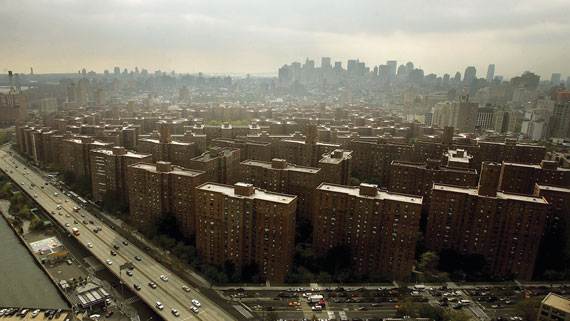
Stuyvesant Town, the 11,232-apartment complex on Manhattan’s East Side.
One developer blamed de Blasio’s troubles on the negative press coverage. The mayor, the developer speculated, has responded by becoming more controlling of his administration — and thus drawing out the decision-making process — in an attempt to prevent blunders.
“New York has all the time in the world to bash Bill de Blasio. It must be thoroughly exhausting for the mayor and it’s naïve to think that doesn’t permeate through,” the developer said. “Sometimes I wish he didn’t care as much.”
The 2017 question
After two years of de Blasio, most industry leaders see the mayor as someone they can work with.
That most in the industry are more critical of de Blasio than they were of Bloomberg is not Earth-shattering news, but the reason for that may be partly grounded in a more basic reason than the differences between the two mayors: Times have changed in the real estate market. Bloomberg, at least during the latter portion of his tenure, negotiated many of his public-private real estate deals in the aftermath of the financial crisis, when financing was hard to come by and new construction rare. One of his goals was simply to promote development in a prohibitive environment, in part by dishing out subsidies.
De Blasio, in contrast, took over during a boom. His goal is no longer just to promote development but to capitalize on the changing market tide by extracting more concessions from developers.
Whether through changes to 421a, the Midtown East rezoning or individual development projects, his administration has squeezed developers a little harder. Inevitably, that was bound to elicit a more mixed reaction from the industry.
But at the same time, this changing market tide has kept developers profitable and happy. “It’s easy to have a good relationship with the real estate industry when the market is strong and it’s easy to generate a lot of development,” argued one executive. “The real test will come when the market becomes weaker.”
Warburg’s Haber argued that while adding more affordable units in exchange for more buildable square footage is acceptable to developers today, it could suddenly be perceived as too burdensome if rents tank. And industry players are growing more concerned about softening in the market.
“In a market that might be slowing down, when you need more incentives to build affordable housing something’s gotta give,” Harber said.
This means that market performance may play a big role in determining who the industry will back in the 2017 mayoral election — when de Blasio could be up against an industry insider like Peebles. But for now, his prospects of winning the industry’s backing in 2017 look surprisingly bright.
“I definitely don’t foresee any active effort on part of the real estate industry to support somebody else two years from now,” said one executive, who is mostly critical of the mayor. “The day after Election Day 2013 I think people would have seriously doubted that.”




